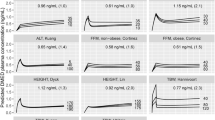Abstract
Purpose
To determine whether continuous administration of nitrous oxide and remifentanil—either alone or together—alters blood flow in oral tissues during sevoflurane anesthesia.
Methods
Eight male tracheotomized Japanese white rabbits were anesthetized with sevoflurane under mechanical ventilation. Heart rate (HR), systolic blood pressure (SBP), diastolic blood pressure (DBP), mean arterial pressure (MAP), common carotid arterial blood flow (CCBF), tongue mucosal blood flow (TMBF), mandibular bone marrow blood flow (BBF), masseter muscle blood flow (MBF), upper alveolar tissue blood flow (UBF), and lower alveolar tissue blood flow (LBF) were recorded in the absence of all test agents and after administration of the test agents (50 % nitrous oxide, 0.4 μg/kg/min remifentanil, and their combination) for 20 min.
Results
Nitrous oxide increased SBP, DBP, MAP, CCBF, BBF, MBF, UBF, and LBF relative to baseline values but did not affect HR or TMBF. Remifentanil decreased all hemodynamic variables except DBP. Combined administration of nitrous oxide and remifentanil recovered SBP, DBP, MAP, and CCBF to baseline levels, but HR and oral tissue blood flow remained lower than control values.
Conclusions
Our findings suggest that concomitant administration of nitrous oxide and remifentanil reduces blood flow in oral tissues without decreasing blood pressure during sevoflurane anesthesia in rabbits.

Similar content being viewed by others
References
Kaneko Y. Experimental studies on vascular changes in fracture and osteomyelitis. Part I: vascular changes in mandibular fracture and healing. Bull Tokyo Dent Coll. 1968;9:123–46.
Fukunaga AF, Flacke WE, Bloor BC. Hypotensive effects of adenosine and adenosine triphosphate compared with sodium nitroprusside. Anesth Analg. 1982;61:273–8.
Bloor BC, Fukunaga AF, Ma C, Flacke WE, Ritter J, Etten AV, Olewine S. Myocardial hemodynamics during induced hypotension: a comparison between sodium nitroprusside and adenosine triphosphate. Anesthesiology. 1985;63:517–25.
Rodrigo C. Induced hypotension during anesthesia, with special reference to orthognathic surgery. Anesth Prog. 1995;42:41–58.
Davies DW, Greiss L, Kadar D, Steward DJ. Sodium nitroprusside in children: observations on metabolism during normal and abnormal responses. Canad Anaesth Soc J. 1975;22:553–60.
Pasch T, Huk W. Cerebral complications following induced hypotension. Eur J Anaesthesiol. 1986;3:299–312.
Kemmochi M, Ichinohe T, Kaneko Y. Remifentanil decreases mandibular bone marrow blood flow during propofol or sevoflurane anesthesia in rabbits. J Oral Maxillofacial Surg. 2009;67:1245–50.
Koshika K, Ichinohe T, Kaneko Y. Dose-dependent remifentanil decreases oral tissue blood flow during sevoflurane and propofol anesthesia in rabbits. J Oral Maxillofacial Surg. 2011;69:2128–34.
Terakawa Y, Ichinohe T, Kaneko Y. Rocuronium and vecuronium do not affect mandibular bone marrow and masseter mauscular blood flow in rabbits. J Oral Maxillofacial Surg. 2010;68:15–20.
Eastwood DW. The pharmacology of nitrous oxide. Clin Anesth. 1964;10:21–35.
Ichinohe T, Homma Y, Kaneko Y. Mucosal blood flow during various intravenous and inhalational anesthetics in the rabbit. Oral Surg Oral Med Oral Pathol Oral Radiol Endod. 1998;85:268–71.
Nishizawa S, Ichinohe T, Kaneko Y. Tissue blood flow reductions induced by remifentanil in rabbits and the effect of naloxone and phentolamine on these changes. J Oral Maxillofacial Surg. 2012;70:797–802.
Bakoshi S, Yoshimura M, Inoue M, Tachibana A, Igawa T, Tamura T, Sato N. MAC of sevoflurane in the Japanese White rabbit (in Japanese). Clin Rep. 1987;21:105–8.
Scheller MS, Saidman LJ, Partridge BL. MAC of sevoflurane in humans and the New Zealand White rabbit. Can J Anaesth. 1988;35:153–6.
Fukunaga AF, Epstein RM. Sympathetic excitation during nitrous oxide-halothane anesthesia in the cat. Anesthesiology. 1973;39:23–36.
Ebert TJ, Kampine JP. Nitrous oxide augments sympathetic outflow: direct evidence from human peroneal nerve recordings. Anesth Analg. 1989;69:444–9.
Ebert TJ. Differential effects of nitrous oxide on baroreflex control of heart rate and peripheral sympathetic nerve activity in humans. Anesthesiology. 1990;72:16–22.
Sellgren J, Ponten J, Wallin BG. Percutaneous recording of muscle nerve sympathetic activity during propofol, nitrous oxide, and isoflurane anesthesia in humans. Anesthesiology. 1990;73:20–7.
Fukuda K. Opioid. In: Miller RD, editor. Miller’s Anesthesia. 7th ed. Philadelphia: Churchill Livingstone; 2010. p. 784–7.
Elliott P, O’Hare R, Bill KM, Phillips AS, Gibson FM, Mirakhur RK. Severe cardiovascular depression with remifentanil. Anesth Analg. 2000;91:58–61.
Reid JE, Mirakhur RK. Bradycardia after administration of remifentanil. Br J Anaesth. 2000;84:422–3.
Kurdi O, Deleuze A, Marret E, Bonnet F. Asystole during anaesthetic induction with remifentanil and sevoflurane. Br J Anaesth. 2001;87:943.
Gan TJ. Risk factors for postoperative nausea and vomiting. Anesth Analg. 2006;102:1884–98.
Author information
Authors and Affiliations
Corresponding author
About this article
Cite this article
Kasahara, M., Ichinohe, T., Okamoto, S. et al. Concomitant administration of nitrous oxide and remifentanil reduces oral tissue blood flow without decreasing blood pressure during sevoflurane anesthesia in rabbits. J Anesth 29, 421–425 (2015). https://doi.org/10.1007/s00540-014-1944-1
Received:
Accepted:
Published:
Issue Date:
DOI: https://doi.org/10.1007/s00540-014-1944-1




